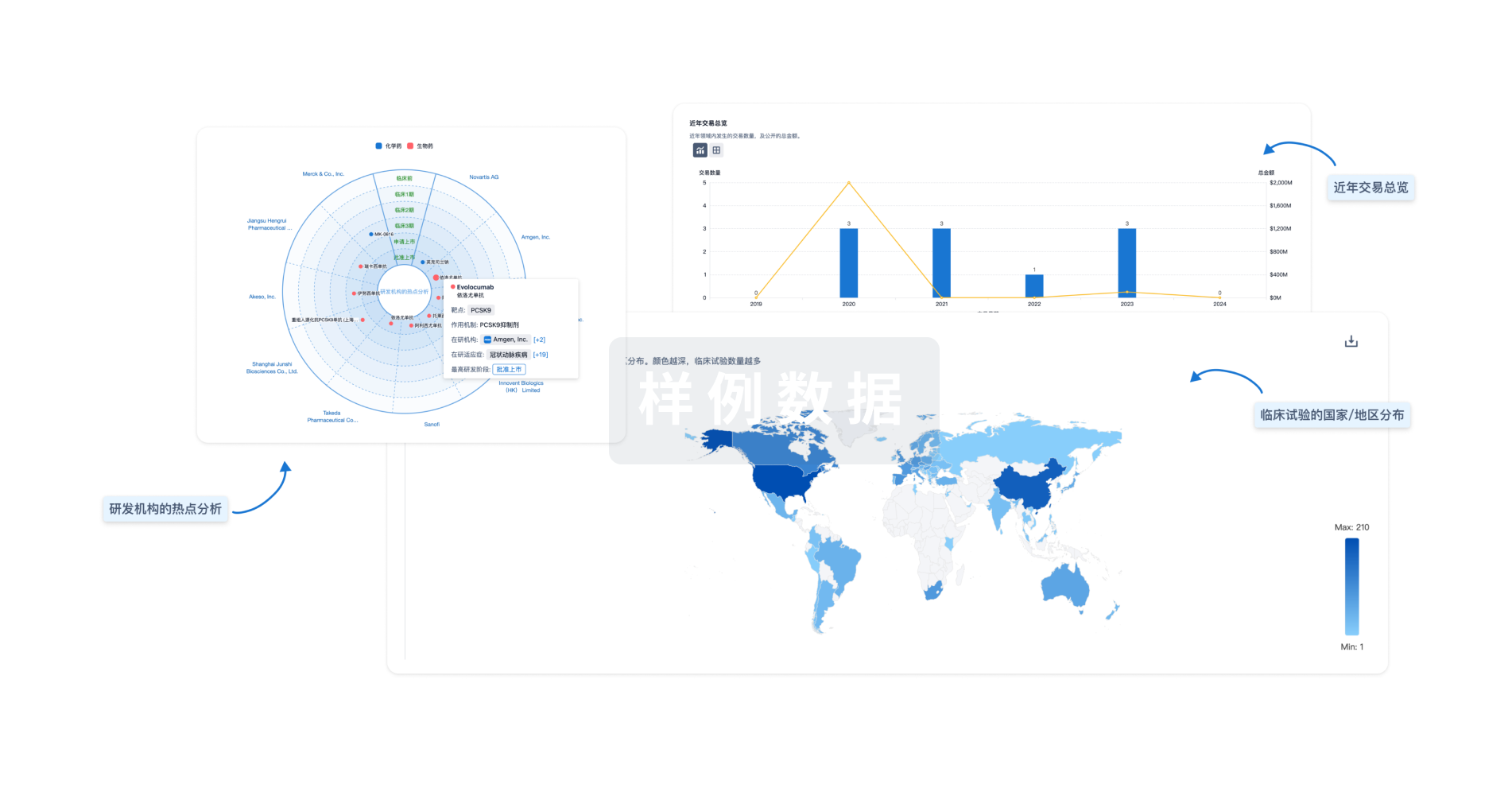预约演示
更新于:2025-01-23
STAT x JAK1
更新于:2025-01-23
关联
1
项与 STAT x JAK1 相关的药物作用机制 JAK1抑制剂 [+1] |
在研机构 |
原研机构 |
最高研发阶段申请上市 |
首次获批国家/地区- |
首次获批日期1800-01-20 |
62
项与 STAT x JAK1 相关的临床试验NCT06731153
A Randomized, Controlled, Open-label, Phase II Clinical Study Evaluating the JAK1 Inhibitor Ivarmacitinib to Reverse Immunotherapy Resistance in Triple-negative Breast Cancer
This is a prospective, open-label, randomized phase II clinical study which recruits unresectable recurrent or metastatic triple-negative breast cancer resistant to immunotherapy.
开始日期2024-12-01 |
申办/合作机构 |
100 项与 STAT x JAK1 相关的临床结果
登录后查看更多信息
100 项与 STAT x JAK1 相关的转化医学
登录后查看更多信息
0 项与 STAT x JAK1 相关的专利(医药)
登录后查看更多信息
1,805
项与 STAT x JAK1 相关的文献(医药)2025-09-01·Neural Regeneration Research
High-dose dexamethasone regulates microglial polarization via the GR/JAK1/STAT3 signaling pathway after traumatic brain injury
Article
作者: Wu, Hongbin ; Deng, Yu ; Yang, Mengshi ; Liu, Baiyun ; Bai, Miao ; Ge, Qianqian ; Niu, Fei ; Zhuang, Yuan ; Dong, Xinlong ; Zhang, Bin ; Xu, Xiaojian ; Lu, Shenghua ; Li, Hao
2025-03-01·Biochemical Pharmacology
Guggulsterone ameliorates psoriasis by inhibiting keratinocyte proliferation and inflammation through induction of miR-17 directly targeting JAK1 and STAT3
Article
作者: Liu, Qiao ; Jiang, Baichun ; Zhou, Yadi ; Wang, Molin ; Sun, Shuna ; Liu, Xiaofei ; Shen, Yangli ; Zhan, Jiafeng ; Liu, Shuangteng ; Zou, Yongxin ; Xiang, Lu ; Fan, Bowen
2025-03-01·Biomaterials
Immunomodulatory hydrogel orchestrates pro-regenerative response of macrophages and angiogenesis for chronic wound healing
Article
作者: Huang, Wei-Yuan ; Ho, Chia-Yu ; Chang, Ling ; Kuan, Chen-Hsiang ; Wang, Wei-Hung ; Tsai, Chia-Hsuan ; Wang, Yi-Ning ; Liu, Yu-Chung ; Wang, Tzu-Wei
177
项与 STAT x JAK1 相关的新闻(医药)2025-01-16
关注并星标CPHI制药在线
开年首笔大交易达成。近日,吉利德和利奥制药(LEO Pharma)宣布建立战略合作伙伴关系。双方将加快利奥制药小分子口服STAT6(信号转导子和转录激活子6)抑制剂的开发和商业化,并计划用于潜在治疗多种炎症性疾病患者。
而就在两周前,强生刚刚以3000万美元预付款引进一款STAT6抑制剂。该靶点有何魅力,引得MNC纷纷重金押注?
吉利德的抗炎版图
在了解STAT6靶点之前,我们先来看下吉利德的近况。吉利德曾经是抗病毒领域明星,凭借治疗丙肝、乙肝以及艾滋病的重磅药物,名利双收。随着重磅产品逐渐迎来专利悬崖,吉利德开始寻找第二增长曲线,除肿瘤外,吉利德开始把目光聚焦在炎症领域。
目前,吉利德在炎症领域主要布局了JAK抑制剂:非戈替尼(filgotinib,Jyseleca)、TYK2抑制剂GLPG3667、JAK1抑制剂GLPG0555。其中非戈替尼是一种JAK1小分子抑制剂,已在欧盟、日本获批上市,用于治疗对一种或多种疾病修饰抗风湿药物(DMARD)应答不足或不耐受的中度至重度类风湿性关节炎(RA)成人患者,也是吉利德目前唯一获批上市的JAK抑制剂,其余两款尚在临床研究阶段。
公司目前还在通过对外合作方式扩大炎症领域布局。2023年5月,吉利德宣布收购生物技术公司XinThera,这是一家聚焦免疫学炎症和精准肿瘤学领域的公司。通过此次收购,吉利德将补充包括炎症/免疫学MK2小分子抑制剂在内的早期管线资产。
同样在2023年5月,吉利德再次加码炎症领域,其与Arcus合作,从之前的肿瘤学研究扩大至炎症领域。两家公司早在 2020年就达成了为期 10 年的 联盟,重点是共同推进从Arcus开发管线中选择的下一代癌症免疫疗法。此后关于炎症领域的合作,吉利德将获得双方共同选定的最多四个适用于炎症性疾病的靶点启动研究项目的独家许可的早期选择权,并向Arcus支付可能高达10亿美元的期权费和里程碑付款。
此次与利奥制药合作开发的STAT6抑制剂进一步扩充了吉利德的抗炎领域管线。根据协议,吉利德将收购利奥制药的临床前口服STAT6小分子抑制剂和靶向蛋白质降解剂。吉利德将领导口服药物的进一步开发工作,而利奥制药将领导STAT6抑制剂潜在局部外用制剂的开发。利奥制药将有资格获得高达17亿美元的总付款,包括2.5亿美元的预付款等。
仅仅只是临床前产品就获得如此重金押注,STAT6靶点有何特殊之处?
MNC抢滩布局的STAT6
STAT6是STAT家族蛋白的成员,在细胞因子信号转导中发挥作用并介导2型辅助T细胞 (Th2) 分化。因此,STAT6 在 Th2 炎症如特应性皮炎或哮喘的病理生理学中具有重要作用,是治疗多种免疫疾病和癌症的治疗靶点。但是由于分子机制复杂、且SH2结构域结合口袋的高极性等问题,导致靶向 STAT6的药物开发一直困难重重。
尽管如此,鉴于STAT6靶点巨大的市场潜力,还是有很多MNC加入该赛道。就在吉利德和利奥制药达成合作协议前不久,强生宣布与日本药企Kaken Pharmaceutical签订独家许可协议,强生将获得一款口服STAT6抑制剂KP-723在全球开发、制造和商业化的权利,该药物处于临床前开发阶段。根据协议条款,强生将向Kaken支付3000万美元预付款、12.175亿美元里程碑金额,以及个位数至低双位数比例的销售分成等。2025年,KP-723预计将开始在特应性皮炎(AD)中的1期临床试验,并可能应用于其他TH2介导的疾病。
2023年7月,赛诺菲和Recludix Pharma合作,共同开发一款临床前口服小分子STAT6抑制剂,用于免疫和炎症疾病患者。根据协议,Recludix将获得1.25亿美元的近期付款,以及可能获得超12亿美元的潜在开发、监管和销售里程碑,以及未来可能的产品销售高达两位数的版税。赛诺菲将拥有小分子STAT6抑制剂的全球权利。
STAT6作为JAK/STAT 信号通路上的关键分子,在维持通路运行和基因表达方面发挥重要的功能,其参与的信号通路与多种疾病有关,是过敏性疾病中Th2炎症的核心驱动因素,在免疫应答、炎症反应以及细胞增殖等多个生理过程中扮演关键角色。除炎症性疾病外,还与淋巴瘤等发病机制相关。据不完全统计,目前在研的STAT6药物约十余种,均处于临床早期阶段,国内在该赛道布局的有杭州百新生物等,处于临床前阶段。
参考来源:
1.https://www.fiercepharma.com/pharma/gilead-s-filgotinib-dream-nears-end-partnership-rebuild-blow-to-ceo-s-diversification-plan.
2.Lu X, Zhou Z Y, Xin Y, et al. Matching-Adjusted Indirect Comparisons of Filgotinib vs Vedolizumab, Tofacitinib, and Ustekinumab for Moderately to Severely Active Ulcerative Colitis[J]. Inflammatory Bowel Diseases, 2023: izad037.
3.https://pubs.acs.org/doi/10.1021/acs.jmedchem.4c01009.
END
扫码领取CPHI & PMEC China 2025展会门票
【智药研习社近期直播】
来源:CPHI制药在线
声明:本文仅代表作者观点,并不代表制药在线立场。本网站内容仅出于传递更多信息之目的。如需转载,请务必注明文章来源和作者。
投稿邮箱:Kelly.Xiao@imsinoexpo.com
▼更多制药资讯,请关注CPHI制药在线▼
点击阅读原文,进入智药研习社~
并购免疫疗法
2025-01-15
今日(1月15日),正大天晴宣布,其自主研发的具有全新化学结构的JAK/ROCK抑制剂罗伐昔替尼片(TQ05105)II期临床试验申请(IND)获得FDA批准,拟用于治疗慢性移植物抗宿主病(cGVHD)。2024年7月,TQ05105已在国内提交上市申请,用于治疗中高危骨髓纤维化(MF)。
TQ05105是一类新型、口服的JAK/ROCK抑制剂。体外试验结果显示,TQ05105能够抑制JAK家族激酶活性及ROCK激酶活性,抑制细胞中STAT3和STAT5的磷酸化水平,从而抑制JAK/STAT信号通路传导作用,发挥抗肿瘤活性,同时抑制ROCK2,重建免疫平衡。
在2024年欧洲肿瘤内科学年会(ESMO)上,正大天晴公布了TQ05105对比羟基脲治疗中高危骨髓纤维化(MF)患者的关键II期临床研究数据[5]。结果表明,TQ05105对比对照组,第24周脾脏体积较基线缩小超过35%的患者比例分别为:58.33% vs 22.86%;TQ05105试验组体质症状最佳改善率为61.11%。患者中毒性可耐受,没有出现新的安全性信号。
此外,正大天晴还在加速推进TQ05105的多项联合研究,以充分挖掘其临床价值,如联合BET抑制剂或BCL-2抑制剂用于治疗中高危骨髓纤维化(MF)的临床研究,已取得较为积极的初步结果。
临床申请临床2期
2025-01-11
据 Insight 数据库「新药获批适应症」模块统计,2024 年中国 NMPA 共批准 90 款新药(不包含新适应症、类似药/改良新及中药,下同),其中国产有 37 款,进口 53 款。
在这些新药中,小分子仍是创新主力,其次是抗体类药物,其他类型药物包括多肽、ADC、细胞治疗、核酸等。
图片来源:Insight 制作
从疾病领域来看,肿瘤仍是创新药汇聚之地,2024 年共批准 31 款抗肿瘤新药;紧随其后的是罕见病和内分泌代谢领域,均批准 12 款新药;其他领域包括神经/精神、自免、感染、血液等,也都有创新产品获批上市。
图片来源:Insight 制作
从获批企业来看,国内企业中正大天晴成为最大赢家,去年有 4 款新药上市,其次是恒瑞、康方、海思科,各有 2 款新药上市。
审评审批方面,2024 年获批新药中,有 14 个突破性治疗药物,其中有 32 个被授予优先审评,有 18 个是以附条件批准的方式获批。
值得指出的是,2024 年 NMPA 批准的 90 款新药中,已经有 19 款通过医保谈判纳入了 2024 年国家医保目录,包括 13 款国产新药和 6 款进口新药。
扫描文末二维码即可下载 2024 年获批的新药完整名单。
国产自免药物大爆发
2024 年国产自免药物迎来密集收获期,有 3 款获批上市,分别是在同一天获批的 IL-17A 单抗(恒瑞医药夫那奇珠单抗、智翔金泰赛立奇单抗),以及康诺亚的 IL-4R 单抗司普奇拜单抗。
上述 3 款药物的获批,标志着国产自免药物的崛起,打破了既往外资药企在该领域的垄断地位。
另外,纵观当下 IL-17A 和 IL-4R 单抗市场,不难发现,IL-17A 单抗竞争更为激烈,全球已有 6 款药物上市,1 款处于申请上市,如何赢得更多市场份额成为制胜关键。
反之,IL-4R 药物领域,全球仅有两款药物上市(即赛诺菲/再生元的度普利尤单抗、康诺亚的司普奇拜单抗),当下竞争相对缓和。但值得注意的是,已有 8 款国产 IL-4R 单抗处于临床 Ⅲ 期阶段,放眼未来,该领域的竞争激烈程度同样不可小觑。
国产双抗迎来重大突破
去年 5 月,康方生物自主研发的 PD-1/VEGF 双特异性抗体依沃西单抗获 NMPA 批准上市,用于联合培美曲塞和卡铂,治疗经 EGFR-TKI 治疗后进展的 EGFR 基因突变阳性的局部晚期或转移性非鳞 NSCLC。
依沃西单抗不仅是全球第一个获批上市的「肿瘤免疫+抗血管生成」机制的双特异性抗体,也是中国第二个独立自主开发获批上市的双特异性抗体新药。
除已经获批的 EGFR 突变晚期非鳞 NSCLC 后线人群的适应症外,更让业界眼睛一亮的是,依沃西单抗在 PD-L1 阳性晚期 NSCLC 一线治疗的 Ⅲ 期临床中取得成功(HARMONi-2 研究),成为全球首个单药头对头击败「药王」 K 药的药物。凭借该结果,康方生物在 2024 年 7 月向 NMPA 递交了上市申请,Insight 数据库预测有望在 25 年 Q1 获批,届时依沃西单抗将改变该领域长期以 PD-1 单抗为主的治疗格局,具有里程碑意义。
EGFR-TKI 继续内卷
肺癌领域 EGFR-TKI 药物在 2024 年持续发力,共有 3 款新药上市。
其中倍而达药业瑞齐替尼、圣和药业瑞厄替尼的获批上市,标志着国内三代 EGFR-TKI 药物市场已然形成六雄争霸局面,竞争持续白热化。
另外 1 款获批的 EGFR-TKI 新药是晨泰医药从阿斯利康引进的佐利替尼,与众不同的是,该药物具有完全穿透血脑屏障的能力,是全球首个针对肺癌脑转移的 EGFR-TKI 新药,为 EGFR 突变肺癌脑转移患者带来了新的治疗选择。
目前国内已获批的三代 EGFR-TKI
图片来源:Insight 数据库整理
多个靶点迎来首款国产新药
首个国产 KRAS G12C 抑制剂
劲方医药自主研发的氟泽雷塞,是国内首个 KRAS G12C 抑制剂,信达拥有中国的开发商业化权益,24 年 8 月获批用于治疗至少接受过一种系统性治疗的 KRAS G12C 突变型晚期非小细胞肺癌。
KRAS 曾有「不可成药」靶点之称,随着 21 年安进公司的 Sotorasib 的上市,众多企业开始扎堆布局 KRAS,截止目前美国和中国各批准 2 款 KRAS G12C 抑制剂,均通过加速批准上市。
首个国产 TROP2 ADC
芦康沙妥珠单抗是科伦博泰开发的一款 TROP2 ADC 药物,已获批用于治疗既往至少接受过 2 种系统治疗的不可切除的局部晚期或转移性三阴性乳腺癌,是国内首个、全球第二个获批上市的 TROP2 ADC 药物。
此外,该药物还斩获了四项 CDE 突破性疗法认定,其用于三线和二线治疗晚期或转移性 EGFR 突变非小细胞肺癌的适应症,也分别在去年 8 月和 10 月申报上市,据 Insight 数据库预测有望在 25 年 Q1 和 Q2 获批。
首个国产 MEK 抑制剂
科州制药的妥拉美替尼获 NMPA 附条件批准上市,用于含抗 PD-1/PD-L1 治疗失败的 NRAS 突变的晚期黑色素瘤患者,成为首款国产 MEK 抑制剂。
淋巴瘤领域全球首个高选择性 JAK1 抑制剂
戈利昔替尼是迪哲医药自主研发的高选择性 JAK1 抑制剂,用于治疗复发难治性外周 T 细胞淋巴瘤(PTCL)。
PTCL 是一种高度异质性和强侵袭性的非霍奇金淋巴瘤,发病机制复杂,一线治疗方案以蒽环类化疗为主,一线治疗后复发患者预后差且缺乏更多有效治疗方案,戈利昔替尼的上市成为了全球首个通过靶向 JAK/STAT 通路治疗复发难治性 PTCL 的全新作用机制新药。
内分泌代谢领域再添重磅新药
替尔泊肽 2 型糖尿病和肥胖适应症均在国内获批
降糖减重领域明星靶点 GLP-1,在去年又迎来一个重磅产品,礼来的替尔泊肽首次在华获批上市。这是目前全球首个且唯一获批的 GIPR/GLP-1R 双靶点激动剂新药,在去年 5 月 和 7 月,其 2 型糖尿病和肥胖适应症相继在中国获批。
在减肥赛道爆火的当下,替尔泊肽的出现无疑让该赛道再起硝烟,同样作为 GLP-1 药物,势必要和早已声名鹊起的司美格鲁肽相提并论。在一项替尔泊肽和司美格鲁肽头对头的 Ⅲ 期研究中(SURMOUNT-5),替尔泊肽在第 72 周的平均减重效果(-20.2%)显著优于司美格鲁肽(-13.7%)。
国产 PCSK9 单抗添新将
降脂明星靶点 PCSK9 在 23 年迎来首个国产单抗获批后(信达的托莱西单抗),24年又有 2 款国产品种走向台前,分别是君实生物的昂戈瑞西单抗和康方生物的伊努西单抗。此外,恒瑞的瑞卡西单抗也在今年 1 月 10 日获批。
至此,国内已经有 7 款靶向 PCSK9 的产品获批上市,包括 6 款单抗,1 款 siRNA 药物。
跨国药企持续发力
从获批数量上看,24 年获批的新药仍以进口居多,其中多家跨国药企的全球首创新药在中国获批。
比如安斯泰来的全球首创靶向 Nectin-4 的 ADC 药物维恩妥尤单抗、强生全球首个靶向 BCMA 和 CD3 的双抗特立妥单抗、礼来全球首个非共价、可逆 BTK 抑制剂匹妥布替尼,以及百时美施贵宝全球首创 Myosin 抑制剂玛伐凯泰等重磅新药均在国内获批,为国内相关患者带来新的治疗选择。
除了上述新药,去年还有很多其它新药获批。如欲了解更多详情,可添加小音微信好友,发送「2024NMPA」即可下载 2024 年获批的新药 Excel。
封面来源:站酷海洛 Plus
免责声明:本文仅作信息分享,不代表 Insight 立场和观点,也不作治疗方案推荐和介绍。如有需求,请咨询和联系正规医疗机构。
编辑:vvy
PR 稿对接:微信 insightxb
投稿:微信 insightxb;邮箱 insight@dxy.cn
多样化功能、可溯源数据……
Insight 数据库网页版等你体验
点击阅读原文,立刻解锁!
上市批准临床3期优先审批抗体药物偶联物突破性疗法
分析
对领域进行一次全面的分析。
登录
或

生物医药百科问答
全新生物医药AI Agent 覆盖科研全链路,让突破性发现快人一步
立即开始免费试用!
智慧芽新药情报库是智慧芽专为生命科学人士构建的基于AI的创新药情报平台,助您全方位提升您的研发与决策效率。
立即开始数据试用!
智慧芽新药库数据也通过智慧芽数据服务平台,以API或者数据包形式对外开放,助您更加充分利用智慧芽新药情报信息。
生物序列数据库
生物药研发创新
免费使用
化学结构数据库
小分子化药研发创新
免费使用


